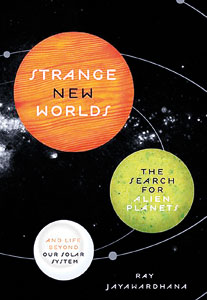I remember the first time the concept of another world entered my mind. It was during a walk with my father in our garden in Sri Lanka. He pointed to the Moon and told me that people had walked on it. I was astonished: Suddenly that bright light became a place that one could visit.
Schoolchildren may feel a similar sense of wonder when they see pictures of a Martian landscape or Saturn’s rings. And soon their views of alien worlds may not be confined to the planets in our own solar system.
 |
| Ray Jayawardhana |
After millenniums of musings and a century of failed attempts, astronomers first detected an exoplanet, a planet orbiting a normal star other than the Sun, in 1995. Now they are finding hundreds of such worlds each year. Last month, NASA announced that 1,235 new possible planets had been observed by Kepler, a telescope on a space satellite. Six of the planets that Kepler found circle one star, and the orbits of five of them would fit within that of Mercury, the closest planet to our Sun.
By timing the passages of these five planets across their sun’s visage — which provides confirmation of their planetary nature — we can witness their graceful dance with one another, choreographed by gravity. These discoveries remind us that nature is often richer and more wondrous than our imagination. The diversity of alien worlds has surprised us and challenged our preconceptions many times over.
It is quite a change from merely 20 years ago, when we knew for sure of just one planetary system: ours. The pace of discovery, supported by new instruments and missions and innovative strategies by planet seekers, has been astounding.
What’s more, from measurements of their masses and sizes, we can infer what some of these worlds are made of: gases, ice or rocks. Astronomers have been able to take the temperature of planets around other stars, first with telescopes in space but more recently with ground-based instruments, as my collaborators and I have done.
Two and a half years ago, we even managed to capture the first direct pictures of alien worlds. There is something about a photo of an alien planet — even if it only appears as a faint dot next to a bright, overexposed star — that makes it “real”. Given that stars shine like floodlights next to the planetary embers huddled around them, success required painstaking efforts and clever innovations. One essential tool is adaptive optics technology, which, in effect, takes the twinkle out of the stars, thus providing sharper images from telescopes on the ground than would otherwise be possible.
At the crux of this grand pursuit is one basic question: Is our warm, wet, rocky world, teeming with life, the exception or the norm? It is an important question for every one of us, not just for scientists. It seems absurd, if not arrogant, to think that ours is the only life-bearing world in the galaxy, given hundreds of billions of other suns, the apparent ubiquity of planets, and the cosmic abundance of life’s ingredients. It may be that life is fairly common, but that “intelligent” life is rare. Of course, the vast majority of the extra-solar worlds discovered to date are quite unlike our own: many are gas giants, and some are boiling hot while others endure everlasting chills. Just a handful are close in size to our planet, and only a few of those may be rocky like the Earth, rather than gaseous like Jupiter or icy like Neptune.
 |
But within the next few years, astronomers expect to find dozens of alien earths that are roughly the size of our planet. Some of them will likely be in the so-called habitable zone, where the temperatures are just right for liquid water. The discovery of “Earth twins”, with conditions similar to what we find here, will inevitably bring questions about alien life to the forefront.
Detecting signs of life elsewhere will not be easy, but it may well occur in my lifetime, if not during the next decade. Given the daunting distances between the stars, the real-life version will almost certainly be a lot less sensational than the movies depicting alien invasions or crash-landing spaceships.
The evidence may be circumstantial at first — say, spectral bar codes of interesting molecules like oxygen, ozone, methane and water — and leave room for alternative interpretations. It may take years of additional data-gathering, and perhaps the construction of new telescopes, to satisfy our doubts. Besides, we won’t know whether such “biosignatures” are an indication of slime or civilization. Most people will likely move on to other, more immediate concerns of life here on Earth while scientists get down to work.
If, on the other hand, an alien radio signal were to be detected, that would constitute a more clear-cut and exciting moment. Even if the contents of the message remained elusive for decades, we would know that there was someone “intelligent” at the other end. The search for extraterrestrial intelligence with radio telescopes has come of age recently, 50 years after the first feeble attempt. The construction of the Allen Telescope Array on an arid plateau in northern California greatly expands the number of star systems from which astronomers could detect signals.
However it arrives, the first definitive evidence of life elsewhere will mark a turning point in our intellectual history, perhaps only rivalled by Copernicus’s heliocentric theory or Darwin’s theory of evolution. If life can spring up on two planets independently, why not on a thousand or even a billion others? The ramifications of finding out for sure that ours isn’t the only inhabited world are likely to be felt, over time, in many areas of human thought and endeavor — from biology and philosophy to religion and art.
Some people worry that discovering life elsewhere, especially if it turns out to be in possession of incredible technology, will make us feel small and insignificant. They seem concerned that it will constitute a horrific blow to our collective ego. I happen to be an optimist. It may take decades after the initial indications of alien life for scientists to gather enough evidence to be certain or to decipher a signal of artificial origin. The full ramifications of the discovery may not be felt for generations, giving us plenty of time to get used to the presence of our galactic neighbors. Besides, knowing that we are not alone just might be the kick in the pants we need to grow up as a species.
Ray Jayawardhana, a professor of astronomy and astrophysics at the University of Toronto, is the author of “Strange New Worlds: The Search for Alien Planets and Life Beyond Our Solar System.” The book was recently
released in the US.
(This article was first published in the New York Times of March 27, 2011) |



